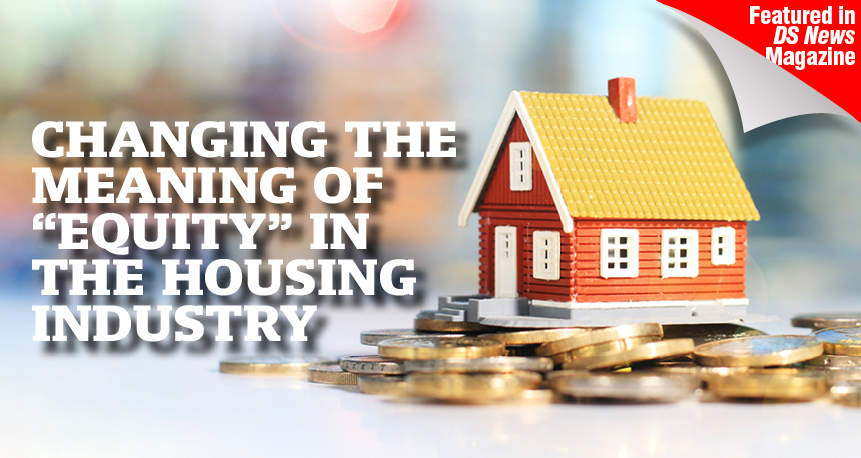
Homeownership is one of the fundamental keys to accumulating wealth in America—hence why it has been integrally linked to achieving the American Dream. Unlike rent payments, monthly payments on mortgage can steadily grow home equity, and the values of residential properties tend to appreciate over time. Not only can owning a home provide a roof over your head and a secure place to live, but because mortgage payments generally remain fixed while rents may rise over time, a home can also be a very effective hedge against inflation. Together, these features can give homeowners an enormous advantage over renters when it comes to accumulating wealth, and for a society where wealth disparities often break along racial and ethnic lines, this can have substantial consequences.
According to the Federal Reserve Board’s Survey of Consumer Finances, a home represents about 75% of all the wealth accumulated by the lowest-income households. For households in the middle of income distribution, housing wealth represents between 50% and 65% of total assets. For the highest income households that have already accumulated wealth, that is only 34%. Also, the cycle is self-perpetuating. A 2018 study by the Urban Institute found that children of homeowners are seven to eight percentage points more likely to be homeowners than children of renters.
Roots of the Racial Homeownership Gap
Within our lifetimes, that path to wealth was deliberately blocked for Black Americans and other historically marginalized communities. The White House acknowledges that “throughout much of the 20th century, the Federal Government systematically supported discrimination and exclusion in housing and mortgage lending. While many of the Federal Government’s housing policies and programs expanded homeownership across the country, many knowingly excluded Black people and other persons of color and promoted and reinforced housing segregation.” In the 1930s, the Federal Housing Administration developed underwriting criteria for mortgages that discriminated against “undesirable” borrowers.
At about the same time, the Federal Home Loan Bank Board developed maps that identified entire “undesirable” communities. The Fair Housing Act abolished many discriminatory practices about 50 years ago, but the results of decades of structural inequity have created tremendous racial disparities in housing, and the effect of those practices can still be seen today.
The ongoing legacies of housing discrimination have contributed to a significant racial homeownership gap. For Black Americans and Hispanic Americans, homeownership rates lag white Americans approximately 30% and 25%, respectively. The racial wealth gap is further widened by a persistent undervaluation of homes owned by Black families. According to a Redfin report from earlier this year, homes in Black neighborhoods are undervalued by an average of $46,000 compared to homes in primarily white neighborhoods. This indicates racial bias in the appraisal process—in fact, appraisal bias has gotten worse over time. A recent study of U.S. home values published by Oxford University found that the appraisal gap between Black and white neighborhoods nearly doubled from 1980 to 2015.
Because of these and other factors, Black households, a majority of which are living on lower-than-average incomes, are more likely to rent their homes and are therefore more vulnerable to disruptions, instability, eviction, and even homelessness, according to the National Low Income Housing Coalition.
Due to pervasive housing segregation, families of color are disproportionately residing in lower-opportunity areas, denying them equal access to quality housing, schools, job opportunities, healthcare, and nutrition. Additionally, minorities experience homelessness and housing instability at significantly higher rates than whites. According to the National Alliance to End Homelessness, Black Americans account for 13% of the general population but more than 40% of the homeless population. Research has shown that housing instability can correlate to a range of negative social outcomes such as poor health, lower academic achievement, and lower economic mobility.
The hard truth is that from real estate covenants to exclusionary zoning and redlining neighborhoods to erecting barriers to borrowing, the housing industry—not just the Federal Government—has played a leading role in perpetuating inequities in the nation’s housing stock. The way to correct for inequitable practices in the past is to champion equity now and in the future not only for Black Americans who have suffered historical and perpetual discrimination, but all groups that have experienced economic marginalization, including people of color, immigrants, individuals living with disabilities, and LGBTQ+ individuals.
What Is Equity?
The housing finance industry is familiar with equity as an investment term that measures ownership of an asset. However, in recent years another definition of equity has been brought to the forefront of public discourse. Now it is common to hear it used in the context of racial equity, social equity, or health equity. So, what does this use of equity mean?
Equity is an approach that ensures everyone fair treatment and access to opportunities. Equity recognizes that advantages and barriers exist and acknowledges that some people begin at an unequal starting place. To ensure equity, we must make a commitment to correct and address the imbalance. This is not the same as equality, which treats everyone equally regardless of their individual circumstances. In fact, equality cannot be achieved without implementing equity.
According to Global Citizen, an organization that fights extreme poverty, “in order for the world to reach a place where everything is fair, just, and equal, we need to prioritize equity and distribute resources based on who needs them most.” For example, a student who is vision-impaired may need extra help in the classroom to give them the same opportunity of academic success as their peers without disabilities.
The Biden administration’s Executive Order On Advancing Racial Equity and Memorandum on Redressing Discriminatory Housing Policies acknowledges the deeply problematic practices that have led to systemic inequality for people of color and other underserved groups, and call on government agencies to eliminate systemic barriers to opportunities. This focus on equity is an important differentiation from the policies that have emphasized equality. As we have learned, attempting to achieve equality without first addressing equity is a losing game. Policies that exist to increase access to homeownership for low-income residents by providing down payment assistance, low interest rates, and financial counseling must ensure they are supporting equitable housing outcomes.
Organizations such as the National Community Reinvestment Coalition have set a goal of raising the rate of homeownership for Black Americans to 60% in the next 20 years. Achieving that goal will likely require concerted action from government and private industry. It won’t be easy but it’s not without precedent. In the past six years, the rate of Hispanic and Latino homeownership, for example, has risen from about 45% in 2014 to over 50% today. Understanding what drives that dynamism and how it can be replicated in other communities will help us all in the long run.
The Housing Industry Must Confront Racial Inequity
Inequities persist, in part, because they often go unrecognized and uninterrogated. As an industry, we have a special obligation to correct the inequities in housing that endure decades after the original discriminatory practices have been discredited and abandoned. Data collection is one area where we can make meaningful improvements. Although data analysis and data modeling can be valuable sources of objective information, implicit biases creep in when data is collected and input by people.
For instance, let’s look at the example of homes in majority-Black neighborhoods being significantly undervalued by appraisers. However, the home valuation process has started to evolve, presenting new opportunities to remove bias from the picture. In the last year, limitations of in-person valuations during the pandemic, coupled with technological advances, have accelerated wider acceptance of alternative valuation products, including automated valuation models (AVMs). AVMs themselves, unlike humans, lack emotion and therefore inherently lack the associated biases. Yet, it is important to understand that models are only as good as the data they are fed, and so, even when applying technology-based alternatives to in-person appraisals, biased data can impact values if not recognized.
At Radian, we have found that using sophisticated artificial intelligence (AI) tools can help remove racial bias from the valuation process. The solution lies in training our models to identify and eliminate bias in the historical data set and feeding fresh data into the modeling tool that is free from human bias. AI can analyze an enormous amount of structured data such as price histories and floor plans, as well as unstructured data like photographs and written information, to establish the true condition of a property. AI can also evaluate newly built properties that have no price histories or recent comparables. However, the most intriguing thing about AI is that it can be trained to learn how to make more accurate valuations by comparing its projected outcomes with actual sales prices and then running through more data combinations until it finds the one that best matches reality.
In addition to developing technology to confront racial bias in housing, Radian has joined forces with multicultural trade associations that share our commitment to helping Americans from underrepresented communities achieve their dream of homeownership. We partner closely with the National Association of Minority Mortgage Bankers of America (NAMMBA), which is dedicated to the inclusion of minorities and women in the mortgage industry and advocating for sustainable homeownership in local communities. We also proudly support the National Association of Hispanic Real Estate Professionals (NAHREP) in its mission to increase the homeownership rate among Latinos. Our team also works with local chapters of the Asian American Real Estate Association of America (AREAA) and The National Association of Real Estate Brokers (NAREB) to provide education and resources to mortgage and real estate professionals serving minority homebuyers. Partnering with multicultural advocacy groups is especially critical in this moment to help ensure equitable recovery from the COVID-19 pandemic, as minority communities have been disproportionately affected.
We also believe a commitment to equity must include employees as well as customers. Our people deserve to be treated with dignity, and we strive to ensure equal access to the same treatment, opportunities, and advancement for everyone who works at Radian. Our intention is to identify and eliminate barriers that may prevent the full participation of our employees in our company. To that end, we have established pay transparency practices, enhanced advancement-focused employee development programs, and employee resource groups (ERGs) to foster equitable treatment and continue to create a safe, supportive work environment for our people.
While we have built a strong foundation thus far, we have developed a multiyear roadmap with aggressive goals to further enrich our Diversity, Equity and Inclusion programs and initiatives for years into the future. Diversity, equity, and inclusion matters, especially in our mortgage and real estate finance industry that is deeply connected to peoples’ aspirations and expectations related to homeownership. And when we do our jobs well, we help make the American Dream a reality for millions of people, especially those who have historically been excluded from the homeownership opportunity.

 DSNews The homepage of the servicing industry
DSNews The homepage of the servicing industry











